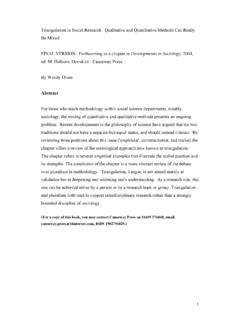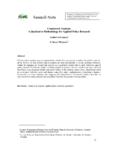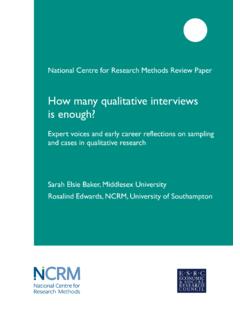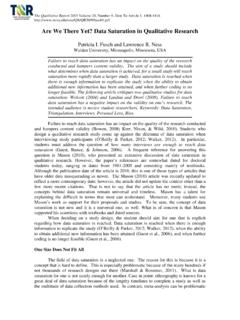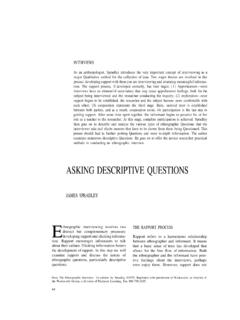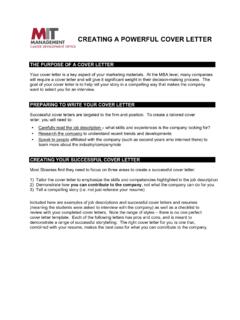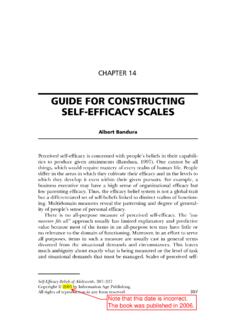Transcription of A Qualitative Framework for Collecting and Analyzing Data ...
1 1 Article A Qualitative Framework for Collecting and Analyzing Data in Focus Group Research Anthony J. Onwuegbuzie, PhD Sam Houston State University Huntsville, Texas Wendy B. Dickinson, PhD Ringling College of Art and Design City, State Nancy L. Leech, PhD University of Colorado Denver Annmarie G. Zoran, PhD Higher Education Centre Novo mesto and University of South Florida 2009 Onwuegbuzie. This is an Open Access article distributed under the terms of the Creative Commons Attribution License ( ), which permits unrestricted use, distribution, and reproduction in any medium, provided the original work is properly cited.
2 Abstract Despite the abundance of published material on conducting focus groups, scant specific information exists on how to analyze focus group data in social science research. Thus, the authors provide a new Qualitative Framework for Collecting and Analyzing focus group data. First, they identify types of data that can be collected during focus groups. Second, they identify the Qualitative data analysis techniques best suited for Analyzing these data. Third, they introduce what they term as a micro-interlocutor analysis, wherein meticulous information about which participant responds to each question, the order in which each participant responds, response characteristics, the nonverbal communication used, and the like is collected, analyzed, and interpreted.
3 They conceptualize how conversation analysis offers great potential for Analyzing focus group data. They believe that their Framework goes far beyond Analyzing only the verbal communication of focus group participants, thereby increasing the rigor of focus group analyses in social science research. International Journal of Qualitative Methods 2009, 8(3) 2 Keywords: focus group, focus group analysis, micro-interlocutor analysis, conversation analysis Authors note: Correspondence should be addressed to Anthony J. Onwuegbuzie, Department of Educational Leadership and Counseling, Box 2119, Sam Houston State University, Huntsville, TX 77341-2119, or e-mail Traditionally, focus group research is a way of Collecting Qualitative data, which essentially involves engaging a small number of people in an informal group discussion (or discussions), focused around a particular topic or set of issues (Wilkinson, 2004, p.)
4 177). Social science researchers in general and Qualitative researchers in particular often rely on focus groups to collect data from multiple individuals simultaneously. Focus groups are less threatening to many research participants, and this environment is helpful for participants to discuss perceptions, ideas, opinions, and thoughts (Krueger & Casey, 2000). Researchers have used focus groups for decades (Morgan, 1998), indeed for the past 80 years. In the 1920s, they were conducted to assist researchers in identifying survey questions (Morgan, 1998). In the early 1940s, Paul Lazarsfeld and Robert Merton, who are credited with formalizing the method of focus groups (Madriz, 2000), used focus group methods to conduct a government-sponsored study to examine media effects on attitudes towards the involvement of the United States in World War II (Merton, 1987).
5 These groundbreaking methodologists used focus group data to identify salient dimensions of complex social stimuli as [a] precursor to further quantitative tests (Lunt, 1996, p. 81). Moreover, according to Kamberelis and Dimitriadis (2005), Two dimensions of Lazarsfeld and Merton s research efforts constitute part of the legacy of using focus groups within Qualitative research: (a) capturing people s responses in real space and time in the context of face-to-face interactions and (b) strategically focusing interview prompts based on themes that are generated in these face-to-face interactions and that are considered particularly important to the researchers.
6 (p. 899) Later, according to Greenbaum (1998), focus group data were collected and analyzed mainly for market researchers to assess consumers attitudes and opinions. In the past 20 years, focus group research has been used to collect Qualitative data by social science researchers (Madriz, 2000). Furthermore, in the past years, books on the use and benefits of focus groups have emerged (Krueger, 1988; Morgan, 1988). Social science researchers can derive multiple benefits from using focus groups. One is that focus groups are an economical, fast, and efficient method for obtaining data from multiple participants (Krueger & Casey, 2000), thereby potentially increasing the overall number of participants in a given Qualitative study (Krueger, 2000).
7 Another advantage to focus groups is the environment, which is socially oriented (Krueger, 2000). In addition, the sense of belonging to a group can increase the participants sense of cohesiveness (Peters, 1993) and help them to feel safe to share information (Vaughn, Schumm, & Sinagub, 1996). Furthermore, the interactions that occur among the participants can yield important data (Morgan, 1988), can create the possibility for more spontaneous responses (Butler, 1996), and can provide a setting where the participants can discuss personal problems and provide possible solutions (Duggleby, 2005). International Journal of Qualitative Methods 2009, 8(3) 3 Literature abounds regarding how to design a focus group, how to select focus group participants, and how to conduct the focus group session group ( , appropriate focus group interview questions, length of focus group interviews, keeping focus group participants on task) ( , Krueger, 1988, 1994, 2000; Morgan, 1997).
8 In a few articles published in health-related journals, authors ( , Carey, 1995; Carey & Smith, 1994; Duggleby, 2005; Kidd & Parshall, 2000; Morrison-Beedy, Cote-Arsenault, & Feinstein, 2001; Stevens, 1996; Wilkinson, 1998) have discussed issues related to the analysis of focus group data. However, there is very little specific information regarding how to analyze focus group data (Nelson & Frontczak, 1988; Vaughn et al., 1996; Wilkinson, 1999, 2004) or what types of analyses would be helpful with focus group data (Carey, 1995; Duggleby, 2005; Wilkinson, 2004). Consistent with this assertion, Wilkinson (2004) concluded: As indicated, compared with the extensive advice on how to conduct focus groups, there is relatively little in the focus group literature on how to analyze the resulting data.
9 Data analysis sections of focus group handbooks are typically very published focus group studies, researchers often omit, or briefly gloss over, the details of exactly how they conducted their analyses. (p. 182, emphasis in original) With this in mind, in the present article we provide a new Qualitative Framework for Collecting and Analyzing focus group data in social science research. First, we delineate multiple avenues for Collecting focus group data. Second, using the works of Leech and Onwuegbuzie (2007, 2008), we outline multiple methods of Analyzing focus group data using Qualitative data analyses. Third, we introduce a new way of Analyzing focus group data, what we term micro-interlocutor analysis, which incorporates and analyzes information from the focus group by delineating which participants respond to each question, the order of responses, and the nature of the responses ( , non sequitur, rambling, focused) as well as the nonverbal communication used by each of the focus group participants.
10 In particular, we conceptualize how conversation analysis offers much potential for Analyzing focus group data. We contend that our Framework represents a more rigorous method of both Collecting and Analyzing focus group data in social science research. The Planning and Organization of the Focus Group The research question and research design ultimately guide how the focus group is constructed. Well-designed focus groups usually last between 1 and 2 hours (Morgan, 1997; Vaughn et al., 1996) and consist of between 6 and 12 participants (Baumgartner, Strong, & Hensley, 2002; Bernard, 1995; Johnson & Christensen, 2004; Krueger, 1988, 1994, 2000; Langford, Schoenfeld, & Izzo, 2002; Morgan, 1997; Onwuegbuzie, Jiao, & Bostick, 2004).
